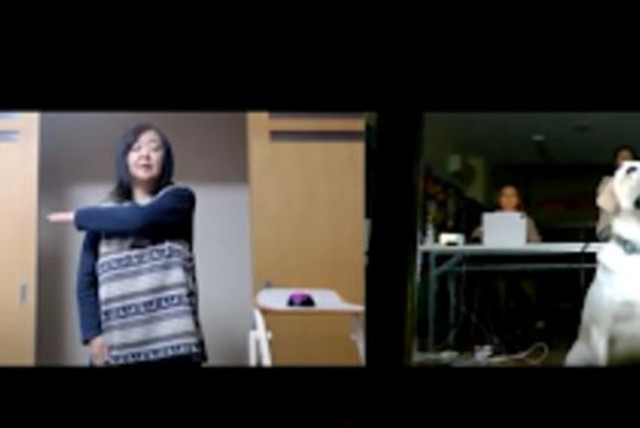Can you communicate with your canine by virtual means?

Dogs can imitate human actions from two-dimensional video projections, say Hungarian researchers
Every dog owner can testify to the fact that canines are very smart, sensitive, and emotionally close to their human “mothers” and fathers.” But do their cognitive abilities include the ability to imitate their owners from viewing a two-dimensional moving image?
It is possible, according to a new study just published in the journal Biologia Futura under the title “Exploring the use of projected videos to test action matching from different perspectives in dogs.”
Whether animals are able to take the perspective of a human is a topic that has received a lot of attention in comparative cognition research. Researchers from the ethology department at Eötvös Loránd University in Budapest found that dogs can imitate human actions from two-dimensional video projections and that this ability aligns with their everyday observational experiences with people.
They used the Do-as-I-Do (DAID) training method with rules like those behind the game “Simon Says” using reinforcement-based techniques to train dogs to copy the behavior of their child owner upon hearing the verbal cue “Do it.”
The researchers trained two dogs – Tara, a male golden retriever and Franc, a female Labrador retriever – to imitate human actions, first from live demonstrations and then displayed on a screen. The setup involved life-size video projections streamed via online conference software, enabling real-time interaction between the dogs and their owners who were in a different place. For example, the owner would spin in a circle in front of the camera of its device and verbally cue the dog to “do it!”
The dog, having observed this action on the screen, was then expected to do the same thing.
"Do as I do" method
The experiment tested the dogs’ ability to imitate actions observed from three different camera angles – frontal, side and above. The tested actions included walking backward, lying down, spinning horizontally, and pushing a buzzer button, among others. The dogs were also tested on their ability to imitate novel actions that were not included in the training, such as picking up an object, touching a pole with their nose, and knocking down a water bottle.
The results showed that dogs could replicate actions observed from frontal and side angles, which are observational perspectives commonly encountered in dogs’ daily lives with humans, but it was more difficult to imitate actions from an overhead perspective, which is a less familiar viewpoint.
“One of the demonstrated actions included knocking down a plastic bottle, shown from an overhead view. Tara observed my demonstration on the screen, looked for the bottle in his room, in front of the screen, and then knocked it down. But he struggled to replicate other actions with an overhead view” said Fumi Higaki, coauthor and Tara’s.
“This study, even if only exploratory, not only advances our understanding of how dogs perceive and interpret human actions, but more importantly, this innovative method could broaden research into several other potential cognitive abilities, and could also be extended to other species,” said lead researcher Claudia Fugazza.
The DAID training method has been employed to study imitative abilities not only of dogs but also of cats, orcas (killer whales, and various other species.
Jerusalem Post Store
`; document.getElementById("linkPremium").innerHTML = cont; var divWithLink = document.getElementById("premium-link"); if (divWithLink !== null && divWithLink !== 'undefined') { divWithLink.style.border = "solid 1px #cb0f3e"; divWithLink.style.textAlign = "center"; divWithLink.style.marginBottom = "15px"; divWithLink.style.marginTop = "15px"; divWithLink.style.width = "100%"; divWithLink.style.backgroundColor = "#122952"; divWithLink.style.color = "#ffffff"; divWithLink.style.lineHeight = "1.5"; } } (function (v, i) { });

